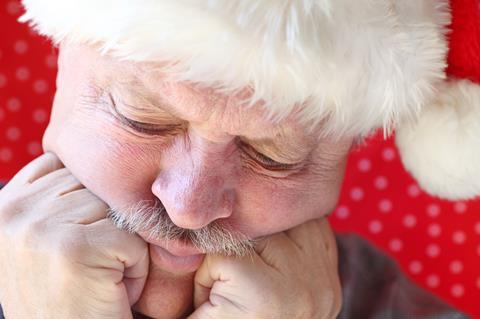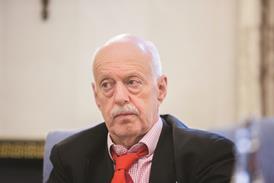A new model may have the answer to the pressures the system faces every January. Dr Vincent Connolly explains

Bed occupancy across the NHS drops significantly on Christmas Eve
The difference in bed occupancy on Christmas Eve, when the culture is to discharge patients back home to be with family, shows that the NHS can get patients out of hospital safely, quickly and effectively. So why can’t this be done every day?
Increase in numbers
There is strong evidence that the first week of January creates blockages in patient flow and disrupts performance across the system for a significant time after. Despite clement weather and no significant flu outbreak, January 2015 showed an increase in ”major incidents” called by trusts, an increase in patients using accident and emergency and being admitted and increasing numbers of handover delays.
This can be down to a number of issues such as poor planning around staff holidays in social care and within trusts, patients presenting after the festivities, and GP surgeries opening after the holidays.
In order to help tackle this issue a pilot project was recently carried out at Colchester General Hospital.
The project focused on a new model created by the Emergency Care Improvement Programme team, which aimed to tackle blockages to patient flow.
The model, known as the #Safer343 bundle, was created by range of clinical experts from the health and care system.
During the pilot, three exemplary wards at Colchester General Hospital were supported in implementing the SAFER patient flow bundle for three weeks.
The SAFER bundle is a simple set of rules (like a clinical care bundle) any system can implement:
S - Senior Review. All patients will have a Consultant Review before midday.
A - All patients will have an expected discharge date (that patients are made aware of) based on the medically suitable for discharge status agreed by clinical teams.
F - Flow of patients will commence at the earlier opportunity (by 10am) from assessment units to inpatient wards. Wards (that routinely have patients transferred from assessment units) are expected to “pull” the first (and correct) patient to their ward before 10am.
E – Early discharge, 33 per cent of our patients will be discharged from base inpatient wards before midday. Medication to take home for planned discharges should be prescribed and with pharmacy by 3pm the day prior to discharge wherever possible.
R – Review, a weekly systematic review of patients with extended lengths of stay (greater than seven days) to identify the issues and actions required to facilitate discharge. This will be led by clinical leaders supported by operational managers who will help remove constraints that lead to unnecessary patient delays.
Work started by taking an in depth look at what was happening on the wards of Colchester General Hospital. Multidisciplinary teams from across the local system walked the wards looking for medically fit patients who could be appropriately discharged.
To ensure continuous improvement an ongoing cultural change is required
The teams challenged rules around unnecessary paperwork and the clinical need for tests, supported staff to go and get the results of tests rather than waiting for them, and together they got a significant number of people safely out of hospital that day, or the next, with the appropriate support from social care. This freed up the flow of patients through the system and led to an empty ambulance bay for the first time in memory and free beds in the emergency department.
Over all, the pilot did lead to a short term positive upturn in performance at Colchester General but to ensure continuous improvement an ongoing cultural change is required.
The #Safer343 bundle is an important aspect of the ECIP. This programme was developed by Monitor, NHS Trust Development Authority, NHS England and the Department of Health to tackle problems in urgent and emergency care.
It is a clinically led programme, led by individuals from both NHS England and Monitor, designed to offer intensive practical help to 28 urgent and emergency care systems under the most pressure this winter.
We know that the longer frail elderly patients stay the more likely they are to “decompensate” (lose muscle mass, confidence and become less mobile) and so the #Safer343 budle was created to increase capacity in emergency care and improve patient flow through hospitals.
Post-holiday blues
Bed occupancy across the NHS drops significantly on Christmas Eve, in 2014 it reduced from 93 per cent on 22 December to just over 90 per cent on 24 December, however this is not a sustained effort based on clear principles. Conversely, in 2014-15, there was a spike in the number of patients waiting over four hours from decision to admit to admission (“trolley waits”) in the days immediately after the festive period. This is in spite of no noticeable increase in attendances in the same period.
ECIP aims to tackle this post-holiday silting up of patient flow across the 28 systems most under pressure on performance against the 4 hour waiting time standard in Q4 of last year and Q1 of this year. This will be done by helping them to run Safer Start campaigns.
Safer Start campaigns include implementation of #Safer343 bundles, but will also include multidisciplinary accelerated discharge events (MADE). These events will last two to three days and involves a multidisciplinary team from each system critically reviewing every patient on agreed wards to understand what the next steps are and to make sure whatever people are waiting for happens with minimal delay.
Before each event the ECIP team is asking all 28 systems to provide levels of senior medical, nursing, diagnostic, social care and therapy cover from 25 December through to the second week of January. They must also ensure all patients’ care is progressed over this time and the impact of reduced decision maker time, over the festive season and in to the New Year, is minimised.
Most Christmas eves have shown it is possible to overcome those blockages
Systems will then have to run their MADE in the first week of January. The event should be supported by executive representation from across the system and have clear and agreed measures for success.
The ECIP team will support these systems in the delivery of the MADE events by coaching the teams prior to the event and offering on the ground support to help them deliver it. This on the ground support will be provided by the ECIST team (emergency care intensive support team) established since 2009.
Increased patient flow saves lives and too often unnecessary complexities, unhelpful processes and lack of ownership of risk silts up the system. Most Christmas Eves have shown it is possible to overcome those blockages. #Safer343 and MADEs challenge leaders to make a change and closer system wide working all make a significant difference to patient safety.



























No comments yet